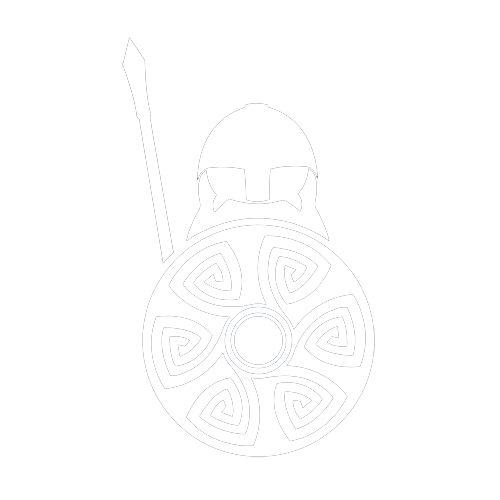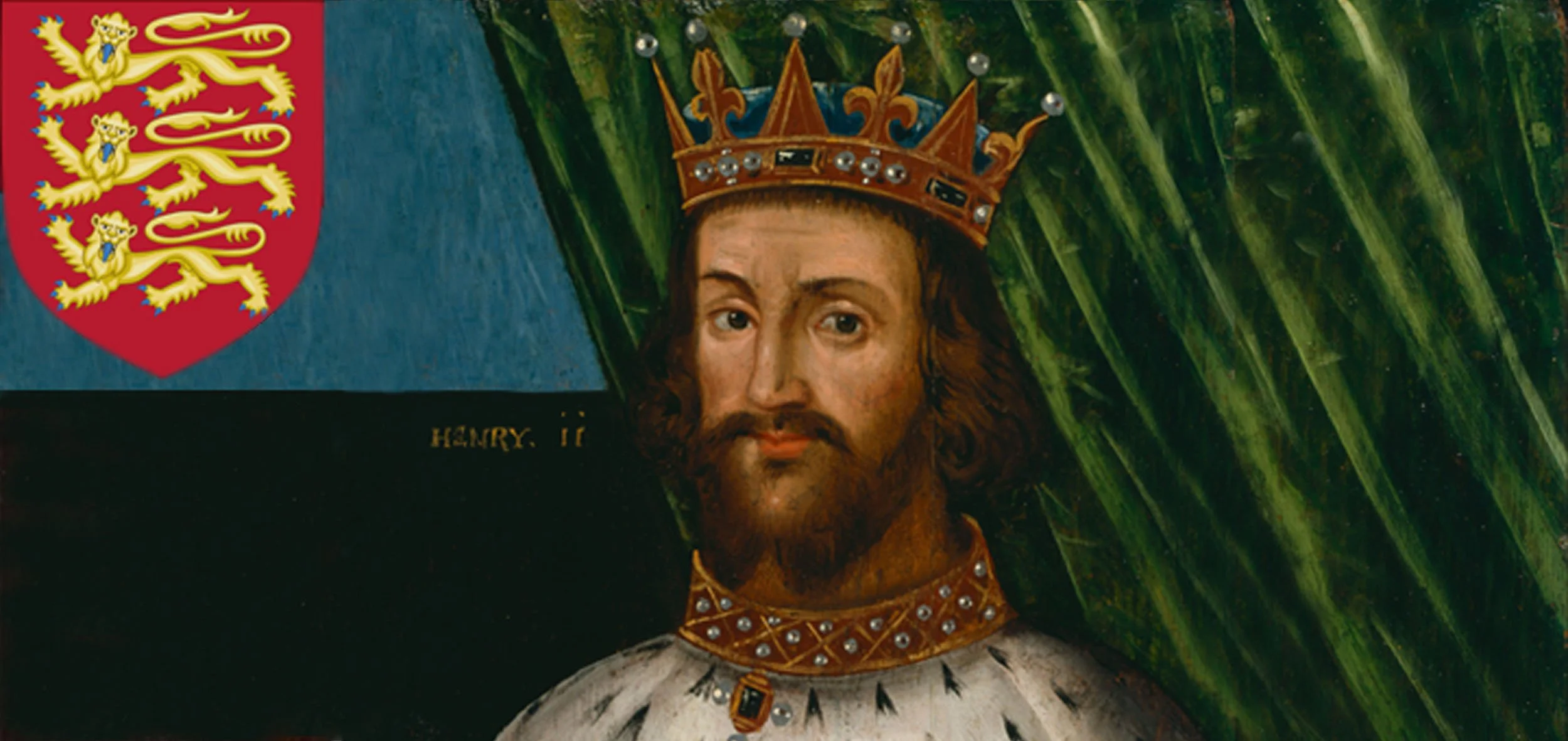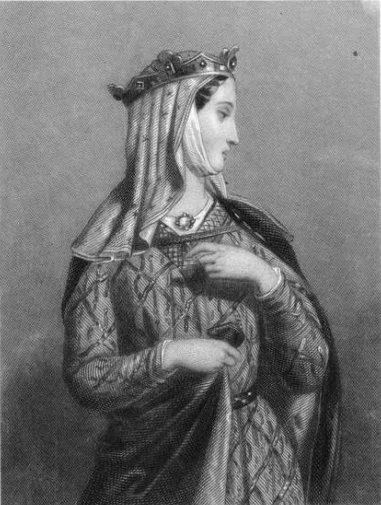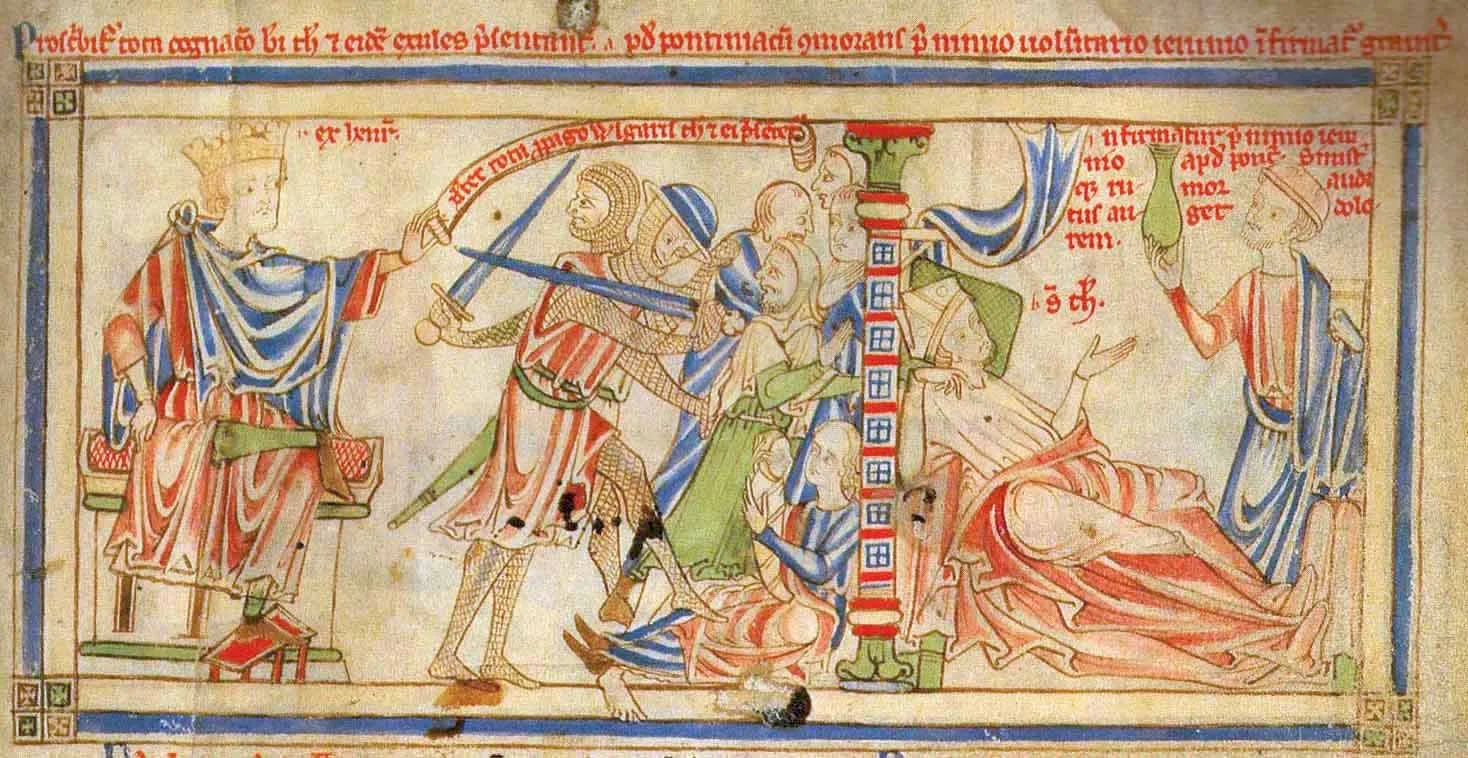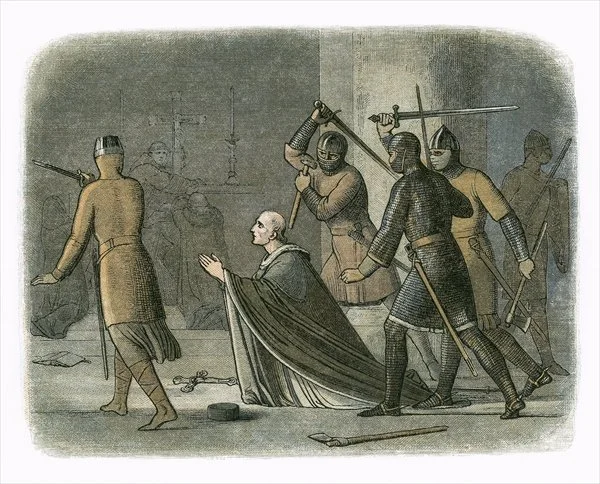King Henry II Plantagenet King of England
King Henry II was the first in a long line of Plantagenet kings of England. Also known as Henry Plantagenet, Curtmantle or FitzEmpress, Henry was the son of Matilda and Geoffrey of Anjou, and grandson of King Henry I. He grew to be a charismatic, intelligent man, who could speak many languages, which proved useful when communicating across his multi-lingual territories as king.
However, Henry II was also renowned for his fiery temper, and extreme outbursts of anger. Perhaps this aggressive temperament made the king successful in controlling his vast Angevin lands, while also making peace after years of civil war left by King Stephen.
| Born | 5 March 1133, Le Mans, France |
| Parents | Geoffrey, Count of Anjou and Empress Matilda |
| Married | Eleanor of Aquitaine, daughter of William X, Duke of Aquitaine |
| Children | 8, inc Henry the young king, Richard I and John |
| Died | 6 July 1189, Chinon Castle, France (56) |
| Reign | 1154 - 1189 (34) |
| Crowned | 19 December 1154, Westminster Abbey (22) |
| Predecessor | Stephen (first cousin once removed) |
| Successor | Richard I Lionheart (son) |
| House | Angevin |
Life Events of King Henry II
1133
On 5 March, Henry II is born in Le Mans, Maine, France. He is the eldest son of Count Geoffrey V of Anjou and Empress Matilda (also known as Matilda of England).
1152
On 18 May, Henry II marries Eleanor of Aquitaine, a powerful French duchess who brings extensive lands and resources to his kingdom. Their marriage significantly increases Henry's influence and territories.
1154
On 25 October, Henry II accedes to the throne of England, as King Stephen dies.
1154
On 19 December, Henry II is crowned King of England at Westminster Abbey.
1164
King Henry II issues a set of legal reforms known as the Constitutions of Clarendon, which seek to assert royal control over the Church and its courts. The reforms are met with resistance from the clergy.
1170
On 29 December, Thomas Becket, the Archbishop of Canterbury and a close friend turned adversary of Henry II, is murdered in Canterbury Cathedral. This event creates a major controversy and strains the relationship between the king and the Church.
1170
Henry II undertakes a penance for the murder of Thomas Becket by publicly submitting to a flogging by monks at Canterbury Cathedral.
1171
Henry II invades Ireland on 18 October and establishes English control over parts of the island, setting the stage for English rule in Ireland that would last for centuries.
1173
King Henry II faces a rebellion led by his sons, Henry the Young King, Richard the Lionheart, and Geoffrey. The revolt, supported by Eleanor of Aquitaine, is eventually crushed, but it strains the relationship within the royal family.
1174
The Treaty of Falaise is signed in December, by King Henry II and King William the Lion of Scotland. This forces Henry's overlordship of Scotland. It would later be nullified by Richard I.
1183
Henry II's son, Henry the younger, dies of dysentery followed by fever, aged 28.
1185
Another of Henry II's sons, Geoffrey, dies after being trampled in a tournament accident, aged 27.
1189
Henry II's son Richard the Lionheart, with the support of Philip II of France, initiates a rebellion against his father. Facing military defeat, Henry II is forced to accept a peace agreement, known as the Treaty of Azay-le-Rideau, which acknowledges Richard as his successor.
1189
On 6 July, King Henry II dies at Chinon Castle in France, at the age of 56. He is buried at the Fontevraud Abbey alongside his wife, Eleanor of Aquitaine, and later, their son Richard the Lionheart.
Interesting Facts About King Henry II
Royal Bloodline
Henry II was the great-grandson of William the Conqueror, who famously led the Norman invasion of England in 1066. This royal lineage gave Henry II a strong claim to the English throne.Marriage
Henry II married Eleanor of Aquitaine, one of the wealthiest and most powerful women in Europe. Through this marriage, Henry gained control of vast territories, including Aquitaine, making him one of the most powerful rulers of his time.Language
Henry II was fluent in several languages, including French, Latin and Occitan. This multilingualism helped him communicate effectively with the diverse nobility and clergy in his domains.Legal Reforms
Henry II made significant contributions to English law and governance. He established a common law system that applied to all of England and introduced legal reforms such as the use of juries to determine guilt or innocence.Court of Assizes
Henry II instituted the Court of Assizes, which travelled throughout the kingdom to hear cases. This court helped centralise legal administration and provided a fairer and more accessible justice system.Military Campaigns
Henry II engaged in several military campaigns to expand his territories. He successfully asserted control over Wales and Ireland, and his forces also waged conflicts against Scotland and France.Thomas Becket
Henry II had a close friendship with Thomas Becket, who became Archbishop of Canterbury. However, their relationship deteriorated when Becket fiercely defended the Church's independence from royal authority. This ultimately led to Becket's murder and Henry's public penance for his involvement.Family Conflicts
Henry II's reign was marked by conflicts with his own family. His sons, Henry the Young King, Richard the Lionheart, Geoffrey and John, rebelled against him at various times, causing political turmoil and challenging his authority.Pilgrimage
Following the murder of Thomas Becket, King Henry II made a pilgrimage to Canterbury Cathedral to seek forgiveness and perform acts of penance. He allowed himself to be publicly flogged by monks, demonstrating his remorse.
Battles Fought By King Henry II
Revolt of 1173-1174
This was not a single battle but a series of conflicts known as the Great Revolt, led by Henry II's sons and supported by various allies, including Louis VII of France and Henry II's estranged wife, Queen Eleanor of Aquitaine. The revolt aimed to challenge Henry II's authority. Multiple battles and skirmishes occurred during this period, including the Battle of Fornham (1173), the Siege of Dol (1173-1174), the Battle of Alnwick (1174), and the Battle of Dol (1174). Ultimately, Henry II successfully suppressed the revolt and regained control.Battle of Fornham
On 17 October 1173, this battle, which was part of the Great Revolt, was fought between royal forces of King Henry III and rebels, led by Robert de Beaumont. The royals defeated the rebels, as they crossed the River Lark. Local peasants killed most of the fleeing rebels.Battle of Dol
On 20 November 1173, this battle was part of the Great Revolt and took place in Brittany, France. Henry II's forces, led by his son Geoffrey, faced a rebellion by Henry's younger sons and their allies. The battle resulted in a victory for Henry II's forces, solidifying his control over the region.
FAQs About the King
Who was King Henry II of England?
King Henry II of England was a medieval monarch who reigned from 1154 to 1189. He was a member of the House of Plantagenet and is often regarded as one of England's most powerful and influential kings.What were Henry II's major accomplishments as king?
Henry II made significant contributions to English governance and legal reforms. He instituted an efficient and centralized legal system, known as the ‘Common Law’, and established royal courts to administer justice throughout the kingdom. He also expanded his territories by incorporating Ireland and parts of France into his domains.What was Henry II's relationship with Thomas Becket?
Thomas Becket, the Archbishop of Canterbury, was initially a close friend and advisor to Henry II. However, their relationship deteriorated when Becket strongly defended the privileges and independence of the Church against Henry's attempts to exert control. Becket's murder in 1170, carried out by followers of Henry, created a lasting controversy.What was the significance of the Constitutions of Clarendon?
The Constitutions of Clarendon were a set of reforms issued by Henry II in 1164. They aimed to restrict the power of the Catholic Church and assert more control over its activities within England. These reforms led to a clash between Henry and Thomas Becket, resulting in Becket's exile and eventual martyrdom.What was the role of Henry II in the murder of Thomas Becket?
While there is no evidence to suggest that Henry II directly ordered the murder of Thomas Becket, his heated disputes with Becket over the authority of the Church and his ambiguous remarks may have indirectly influenced his followers to carry out the assassination. Henry publicly expressed remorse and performed acts of penance in response to the murder.How did Henry II's reign contribute to the development of English law?
Henry II's reign is often associated with the development of the English legal system. He expanded the jurisdiction of royal courts, introduced legal reforms such as trial by jury, and established a uniform body of laws for the entire kingdom. These developments laid the foundation for the English legal system that continues to this day.How did Henry II's reign end?
Henry II's reign ended with his death on 6 July 1189. He was succeeded by his eldest surviving son, Richard the Lionheart, who became the next king of England.What is Henry II's historical legacy?
Henry II's reign marked a transformative period in English history. His legal reforms and administrative changes laid the groundwork for a more centralized and efficient government. His conflicts with Thomas Becket and his own family, while tumultuous, shaped the dynamics of power and the relationship between the crown and the Church. Henry II is remembered as a strong and influential ruler whose reign left a lasting impact on England.
Further Reading
King Henry II and the Angevin Empire
The Angevin Empire was not really an Empire. It wasn't like the Holy Roman Empire, and some argue that King Henry II's lands were not centralised, powerful or large enough to be a proper empire. Still, the territories Henry ruled were indeed vast, ranging from Scotland down to the South of France, and was the largest 'empire' in Western Europe.
Eleanor of Aquitaine
King Henry II already ruled lands in France as Count of Anjou, Duke of Normandy, Duke of Aquitaine, Count of Maine and Count of Nantes. Henry's territory and power was soon increased again, with a marriage to a formidable wife to be.
The King of France, Louis VII, annulled his marriage to Eleanor of Aquitaine in 1152, as no male heir could be produced. Henry and Eleanor married the same year, expanding Henry's territory further. So much so in fact, that Henry ruled more land than his overlord, Louis VII of France!
Eleanor of Aquitaine was a powerful woman, and one of the wealthiest women in Europe. She inherited the Duchy of Aquitaine from her father, William X, in 1137. Later on in her marriage to King Henry II, she would prove to be a force to be reckoned with, and would not take second place to any mistresses of the king!
Accession to the English Throne
In 1153, Henry invaded England with a small army, and with gathering Angevin support he tried to conquer the north of England. However, a truce was formed with King Stephen much to the outrage of Eustace, Stephen's son. Shortly after, Eustace died suddenly and Stephen had no choice but to accept Henry's accession to the throne of England. King Henry II now ruled over England and most of France.
King Henry II the Castle Breaker
The first agenda on Henry's list as king, was to re-establish royal authority and complete dominance, over the powerful Anglo-Norman barons. These barons had been doing as the please, pretty much, during King Stephen's reign and the Anarchy civil war. Creating their own realms within the kingdom, and ruling as they please. This, in the eyes of King Henry II, had to be stopped. Henry set about destroying all unlicensed castles across England, tearing down and slighting so many, that the king would become known as the 'Castle Breaker'.
The next task on his list, was to regain his lost territories in Northumbria and Cumbria, from Malcolm IV of Scotland; and secure vassalage from the princes in Wales. These were successful campaigns, and a few years after King Henry II's accession to throne, England was stable. Henry could now afford to travel extensively throughout his territories in England and France, spending most of his time in the latter. His lands would flourish under his control, and Henry was secure in the knowledge that he had the backing of Pope Adrian IV (an Englishman, born Nicholas Breakspear), who fully recognised Henry's kingship and his authority over Ireland.
King Henry II establishes Assizes of Clarendon and Northampton
Lawlessness and land ownership entitlement was a big problem during this time, and something that needed controlling. Land owners leaving the country for extended periods on Crusades, would return to find squatters taking up home in their castles and houses. Mercenaries left over from the civil war, who no longer had lords to pay them, would begin spates of robbery and violence.
In 1166, King Henry II set about to improve procedures relating to common law, in the Assize of Clarendon, to address these issues. At the royal hunting lodge of Clarendon, Henry and his lords established the first trial by jury, consisting of 12 men in each hundred and 4 men in each township. The jury would be responsible for naming any criminal suspected of serious crimes in their area, including robbery and murder. Usually amputating a foot was the punishment, however execution was also used for more serious crimes. However, this led to some miscarriages of justice, where accusers would wrongly accuse defendants of crimes they perhaps did not commit.
In 1176, the assizes were updated with the Assize of Northampton. Forgery, counterfeiting and arson where now included in the list of crimes, and punishment could be the amputation of a hand too. Furthermore, the Assize of Northampton appointed six groups of justices to tour the country. Their role was to uphold the rights of land owners, making the possession of land guaranteed by law. This allowed judges to recover lost lands for their returning true owners. These assizes managed to transfer power from local barons to the royal court and judges.
King Henry II and the Murder of Thomas Becket
King Henry II was growing increasingly concerned over the Church's power and dominance. Henry, who was renowned for his ability to control and establish order under his command, found that he could not do so with the Church, and in particular his once friend, Thomas Becket. Thomas Becket was the Archbishop of Canterbury, and held significant power.
Henry, who was cracking down on lawlessness, had delivered the Constitutions of Clarendon to the church, for them to sign and approve. The Constitution was an attempt to curb the Church's power and the extent of Papal authority in England. Restoring the judicial systems back to the royal court, just as they were during the reign of Henry's grandfather, King Henry I. One of the laws in the Constitution was that all priests would have to be tried in a royal court, under a royal judge, if they had committed a crime. Before this law, they would have been tried by a bishop instead.
Thomas Becket refused to accept and sign this new law. King Henry II was outraged, and a heated argument followed at the great council in Northampton Castle, in 1164. Thomas Becket and his family were forced into exile, and fled England, remaining in exile for six years. During the six years, the Pope acted as an intermediary between King Henry II and Thomas Becket. Becket, at one point, threatened to excommunicate England, but the Pope voted for a more diplomatic solution.
King Henry II exiles Thomas Becket
In 1170, Henry eventually compromised, and allowed Thomas Becket to return to England. However, in June that year, more trouble would follow. The Archbishop of York, the Bishop of London and the Bishop of Salisbury crowned King Henry II's son, Henry the younger, as heir apparent. Thomas Becket found this a breach of Canterbury's privilege of coronation and excommunicated all the Bishops. Upon hearing this news, King Henry II flew into another rage, and uttered:
“Will no one rid me of this turbulent priest?”
The murder of Thomas Becket
Four of Henry's loyal knights, William de Tracy, Reginald Fitzurse, Hugh de Morville, and Richard le Breton interpreted this as a royal command, and set out to find Thomas Becket. Becket was found in Canterbury Cathedral in December 1170, and was almost expecting the knights as they arrived. They surrounded Becket, and brought down blow after blow of heavy swords onto Becket's head and torso, splitting his head wide open and apparently spilling is brains out across the stone floor.
News of Thomas Becket's death spread quickly, and was widely condemned. King Henry II was devastated by this death, and could not believe that his words uttered on that fateful night, would result in the Archbishop's murder. Thomas Becket was later canonised a saint and martyr, in 1173, by Pope Alexander III, and in 1174, Henry paid penance by entering Canterbury Cathedral in bare feet, and knelt before Becket's tomb. He was then flogged by the priests in further penance.
King Henry II and his Family Rebellion
King Henry II had already confirmed Henry the younger, his oldest son, as heir, who would inherit Anjou and Normandy (His first son, William had died at a young age of a seizure). Richard, Henry's third son, would inherit Aquitaine; Geoffrey, Henry's fourth son, would inherit Brittany and John, Henry's fifth son, would inherit Ireland. But frustrated by the lack of real power and authority, Henry's sons were becoming rebellious and after Thomas Becket's death, King Henry II's powerful reign began to crumble around him.
Revolt of 1173–74
Henry's wife Eleanor of Aquitaine was growing resentful about Henry's passion for mistresses. A powerful woman, Eleanor plotted to overthrow Henry while visiting Poitiers, and to advance her favourite son's (Richard) ambitions.
In 1173, Henry the younger, Richard and Geoffrey rebelled against Henry II, encouraged by Eleanor. They first invaded Normandy, along with the Bretons from Brittany and the King of France, who were appalled at the murder of Thomas Becket. But ultimately the rebellion failed and was quashed by Henry. Further rebellions continued in the North of England, while Nottingham and Norfolk were burned.
King Henry II, who was dealing with the Normandy rebellion, returned to England to address the uprisings there. Local royalists managed to surprise and capture the Scottish rebel king, William the Lion, and soon after, the rebellion was crushed. Henry's sons then swore allegiance back to their father once more, as their lord and king. Queen Eleanor was placed under house arrest. Only John, Henry's youngest son, appeared to remain loyal to Henry through this time.
In the summer of 1183, Henry the younger contracted dysentery and later died of fever, aged 28. As he was dying, Henry gave penance for his rebellion against his father, and wished to be reconciled with him. Upon his death, King Henry II was said to exclaim:
“He cost me much, but I wish he had lived to cost me more”
Henry II's woes would continue with the death of his third son, Geoffrey, who died in 1185, after being trampled in a tournament accident, aged 27. Geoffrey's good friend and ally, Prince Philip of France, was devastated. The two had allied against King Henry II on a number of occasions.
By 1189, Richard's relationship with his father, Henry II had deteriorated. King Philip II of France exploited this and allied himself with Richard, despite being friends with Henry II initially. Both Philip and Richard wanted Henry to name Richard as his heir, but Henry was stalling. At this, Richard publicly paid homage to Philip in front of the nobles and launched a surprise attack on Henry II.
King Henry II, now very weary from ill health, had no choice but to negotiate a surrender. Worse still, Henry had discovered that his only loyal son, John had turned against him and allied with Richard. This was the last straw for Henry, and he died (apparently from a broken heart) 2 days later in July 1189, aged 56, at Chinon Castle in France.
